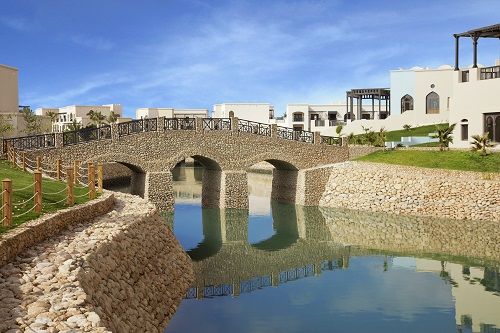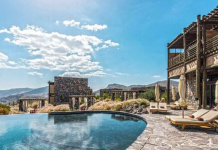With a 20-year tourism strategy already bearing fruit, the Sultanate appears well on track to hit its target of 11 million tourists annually by 2040
For centuries Oman has been an important transcontinental crossroad, a trading hub between east and west and a popular stopover point between Asia, Europe and Africa. Once known as the Gulf’s hidden gem and home to stunning natural assets that include rugged mountains, pristine beaches with crystal-blue waters that define the word ‘azure’ and forts straight out of tales of the ‘Arabian Nights’, the Sultanate is now getting kitted out with massive tourism infrastructure, positioning itself as a magnet for business visitors and a must-visit destination for leisure tourists.
With an ambitious goal to attract 11 million visitors annually by 2040, the government has invested heavily in numerous projects to help boost the tourism sector. State-of-the-art airports, an ambitious national airline and a host of exciting new developments including a modern convention centre constructed to help the Sultanate compete for major conferences are set to help Oman reach its tourism goals. Oman is also sharpening its focus on niche tourism segments, from adventure travellers to group business and the meetings industry. Some of the most important objectives of the Oman Tourism Strategy include increasing the contribution of the sector to the GDP to 6-10 per cent, creating 535,000 jobs in the sector, achieving social responsibility index of 850/1000, achieving over 11 million international and local tourists and achieving 14 million room nights.
Showing a significant progress in the implementation of the strategy, the performance indicators of the tourism sector in 2018 reflected a significant development compared to 2017. The number of hotels of all categories increased to 412 in 2018 compared to 367 in 2017. The direct added value of the tourism sector in 2018 rose to 912 million in 2018, compared to 728 million in 2017. The total contribution of the sector to the GDP stood at 9.2 per cent in 2018 compared to 6.2 per cent in 2017.
World Travel & Tourism Council (WTTC) in a recent report revealed that the travel and tourism sector could provide additional employment to 260,500 people by 2029, the number is around 50,000 higher than the present figure of 209,900 people engaged in such activities. WTTC report said that in 2018, foreign inbound tourists contributed RO1.21bn to Oman’s economy. According to the report, India, which contributes significantly to the sultanate’s foreign workforce, also accounted for the maximum, 19 per cent of the total foreign tourists arrived in 2018, while neighbouring country United Arab Emirates came at the second place with just 11 per cent share in inbound arrivals.
As per the report, around 2.8 million visitors from different countries are expected to visit the sultanate this year. It also indicated that around 68 per cent of the total money spent by tourists is on leisure activities while business spending accounts for the remaining 32 per cent share in overall spending.
Getting a facelift
Oman is making great strides in the Meetings, Incentives, Conferences and Exhibitions (MICE) sector. The selection of the Sultanate as the official partner of ITB Berlin 2020- the world’s largest travel trade show is one of the recent achievements in this regard. This will increase Oman’s attractiveness before a global audience in 2020.
Oman Convention and Exhibition Centre boasts of 22,000 square metres of exhibition space and 55 meeting rooms. This striking complex has hosted a number of large international conventions already this year and has won several bids that will bring huge numbers to the Sultanate in the years to come. This property will complement Oman’s MICE sector growth, thanks to 1,200 square meters of functions space, two grand ballrooms and six meeting and board rooms.
The state-of-the-art centre has already hosted close 300 events since it opened two years ago and has significantly contributed to the Sultanate’s business sector’s growth. OCEC has already secured some large conferences, including SICOT 2019, World Hospital Congress 2019, and World Cancer Congress 2020 among many others. This will bring in more than 40,000 visitors until 2024.
The Oman Convention Bureau under the Ministry of Tourism is working hard to promote world-class offering and expects to see significant growth when it comes to attracting corporate visitors. There are a host of new hotels and resorts in the pipeline that will further strengthen Oman’s hospitality portfolio, making it a top choice among planners.
Additionally, it is now easy to visit Oman thanks to an online visa system and the major expansion works that were recently completed at Muscat International Airport. Oman Air is also growing rapidly and is expected to operate up to 70 aircraft and fly to 60 destinations by 2022.
And it is not just the capital that is drawing in visitors. Salalah now has an excellent selection of hotels and a modern airport that is receiving an increasing number of flights. With so much to offer, it is not surprise that tourist numbers are continuing to rise. With plans to further diversify the tourism sector and significantly expand its offerings, Oman is set to thrive in the years ahead.
However, these are far from the only ventures the Sultanate is undertaking as it is looking to attract 11 million international visitors annually by 2040. There are more than 50 hotels set to be constructed in the coming years, a new urban development is set to transform the face of Muscat and a new e-visa system has been introduced in order to make it even easier for tourists to visit the country.
With Oman set to welcome a growing number of visitors, the hospitality sector in the Sultanate is set to grow substantially. In terms of properties, 550 hotels are expected to begin construction or are currently being constructed within 2019 and 2020. They will add another 4,763 hotel rooms to the sector, with the opening of JW Marriot at Madinat Al Irfan at the OCEC.
Furthermore, Jumeirah Muscat Bay is another major hotel set to open this year, with its launch expected in the fourth quarter of 2019. The five-star property has been designed as a retreat on the waterfront, with the aim of offering guests luxury amidst nature. (see interview). There is also the150-room Mandarin Oriental Muscat and 155 residences at Mandarin Oriental, expected to open on 2021.
Muscat’s new downtown
One of the most important projects currently under development in Oman is the construction of Madinat al Irfan. Set to be built over 20 years at a cost of $12.9bn, the project will span across 4.5 million square metres of land adjacent to OCEC and is set to become a new downtown area for Muscat.
A joint venture between Oman Tourism Development company (Omran) and Dubai-based real estate developer Majid Al Futtaim, this mixed-use development will feature 11, 000 residential units, 100,000 square metres of retail space, 700,000 square metrers of office space and several cultural and lifestyle offerings.
The project is of extreme importance in the light of Oman’s national economic diversification agenda and reflects Omran’s strategic roles as a catalyst for investment that form robust partnership with developers. Such ventures will lead to the development of sustainable urban destinations and the generation of significant socio-economic benefits for the Sultanate. It is also expected to create more than 30,000 direct and indirect jobs in the country.Madinalt Al Irfan is also expected to attract even more conferences and exhibitions in the coming years.
Aviation
Oman’s aviation sector is playing equally important role in attracting record numbers to the country. The Sultanate’s national airline, Oman Air, has invested heavily in its fleet and is carefully identifying new flight paths, while $1.8bn was spent constructing a new terminal at Muscat International Airport.
This expansion helped the airport post record numbers in 2018 and increase the capacity to 20 million passengers per year. There is also the potential for a further expansion that would see the capacity rise to more than 50 million passengers per annum in the next decade.
The fact that the airport recorded more than 11 million passengers in the period of January through to September 2018, a 9.8 per cent increase over the same period last year is extremely encouraging. The government envisions the airport’s capacity to be adequate until 2028 as the new terminal is designed to accommodate up to 56 million passengers per annum.
The passenger numbers at the airport have been growing consistently since 2012 at an average rate of 13.3 per cent per year, including the first nine months of 2018. If this pace of growth continues, the new terminal will reach its capacity in 2028.
The government also expects easy connectivity and ease of travel to cement the airport’s position as a hub, in addition to encouraging more tourists. Oman Air has launched new destinations this year, connecting the Sultanate to Moscow, Casablanca and Istanbul, and the route network has so far been selective, with a special focus on the Middle East, East Africa, Southeast Asia and Western Europe. Ultimately, all of these developments will play vital roles in attracting more and more holiday-makers to Oman.
Heritage tourism
Alongside the large-scale developments taking place in the country, Oman is ensuring it still places an emphasis on its natural assets and cultural attractions. The recently developed Oman Tourism Strategy (OTS) has recognised and highlighted the importance of preservation and sustainability of the local environment as tourism develops at a rapid pace. Two aspects of the environment have been identified: natural and cultural.
Firmly rooted in its proud heritage and history of seafaring, trading and exploration, Oman’s long-standing traditions merge seamlessly with modern times, thus offering visitors a genuine blend of ageless Arabian tradition and modernism. Travellers can even see the latest fashion and electronics brands sold alongside traditional handmade crafts and jewelry at souqs around the country which reflects the diversity and richness of this culture.
Oman’s architecture is also reflective of this diversity. For instance, the Royal Opera House Muscat, Sultan Qaboos Grand Mosque and well-preserved villages and attractions like the National Museum, old forts and watchtowers like Bahla fort, and several UNESCO world heritage sites- are all icons that offer glimpses into the heritage and culture of this country. The fact that there is no dearth of attractions and grand cultural symbols help the Sultanate maintain a keen focus in promoting them in more appropriate ways.
Promoting the country as a diverse destination which encompasses everything from the beach and luxury to culture and adventure is helping to attract visitors. The Ministry of Tourism is participating in leading international trade of 11 million international visitors that was envisioned within the Oman Tourism Strategy 2040.
The Sultanate is keen on identifying and participating in trade show, which it utilises to create awareness of Oman’s varied tourism offerings. The country also organises familiarisation trips throughout the year, and these target social influencers, media and trade companies that eventually report their trips in their respective platforms and promote Oman in these markets.
This has proved very successful, as has the establishment of eight international representative offices in the GCC, Ireland, Italy, France, Switzerland, Holland, India and Germany. The government has also opened an office in Russia and is gearing up to explore new markets such as China and the United States.






